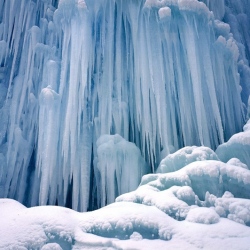
Researchers have developed a clever way to achieve the lowest temperatures ever recorded on Earth.
Achieving such temperatures is necessary to study fundamental properties of matter and the strange effects caused by quantum mechanics.
The new method relies on "optical lattices" of atoms from which only the hottest atoms are selectively removed.
The approach, reported in Nature, may be well-suited to create memory for future quantum computers.
The limits of low temperature have been constantly pushed in recent years, and the current best lies somewhere in the nanoKelvin regime – that is, within just billionths of a degree of "absolute zero" at zero Kelvin or -273.15C.
That ultimate limit is set formally as the lowest possible entropy, or disorder, that is achievable.
Optical lattices are an ideal system in which to attain temperatures ever nearer that limit. The peaks and troughs of intensity in crossed beams of light form a kind of "egg-crate" structure in which atoms are inclined to remain in the troughs – a point of lowest energy.
